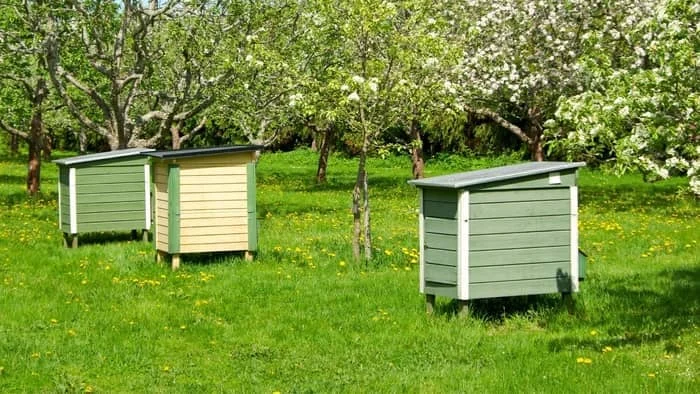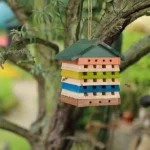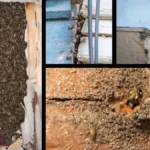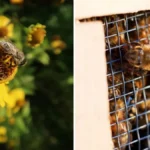How far apart should beehives be placed? This is a complex question to which there are many answers. This will depend on how you wish to keep your bees, and what your objectives are. Let us take a closer look at how we decide the spacing of our hives.
A Quick Summary Of How Bees Find Their Hive
When bees navigate they use a complex set of mathematical calculations based on the angle of the Sun and time of day. When they get close to their hive they also use visual cues – trees nearby, the color of the hive, shapes on the front of the hive, and so on to find the entrance and enter the hive.
Young bees emerge from the hive after working for a week or two in the hive. As they graduate to become forages they first will leave the hive to go on so-called “cleansing” flights where they empty their stomachs (bee poop). These young bees will then fly out and orientate – they learn where their hive is. This is a complex time in a bee’s life!
After bees have orientated, they will then begin their first foraging trips over the next few days. During this time you have rookie bees flying out on their first flights to flowers, and they come back, tired confused, and sometimes a bit unsure of where their hive is!
If a bee enters the wrong hive by mistake, this is called drifting.
Drifting Explained
When we refer to drifting in bees it basically refers to a bee flying back into the wrong hive. There are two things that can happen with drifting. One – the bee gets killed. This means that both hives have a loss. The donor hive loses a forager, and the recipient hive can sometimes lose a guard (depending on where she stung the lost bee she can either lose her stinger and die, or she will survive if the stinger does not get stuck).
In the event that the recipient hive receives a forager, this hive has gained a worker!! If we imagine a long line of white boxes that all look the same, and are all orientated the same way, it is easy to see how bees can get confused and drift to one hive over all the others. This normally results in a hive at the end of a row of hives getting much stronger than all the other hives!
For commercial beekeeping, beekeepers have space constraints and have to make do with the hand dealt with them by conditions. For a beekeeper who is running a few hives in the backyard and a few other apiaries, we can be a bit more specific about how we avoid drifting issues.
This brings us to bee management and brings us to the question of “How far apart should beehives be placed?”
Before we can get to that question, however, let us first look at what direction hives should face.
In Which Direction Should Beehives Face?
Ideally, bees need to fly out of the hive and see the Sun. This means it is easy for them to navigate, and it also means that they can start the day early and end late, as the Sun gives them a little bit of heat on colder days. I have often looked at two hives on a pallet – one facing the Sun and one facing away. As it gets cooler in the evening, the Sun-facing hive is busy, the other hive has a whole lot of cold bees on the ground in front of the hive that did not quite make it home. This means the Sun-facing hive produces more honey!!
So this means that your hive should face the equator. In the Northern Hemisphere, your hive should face South and in the Southern Hemisphere, the hive should face North. This is not a hard and fast rule – sometimes when it is really hot you may find that your hives benefit from being placed in such a way that they get a bit less midday Sun, or even get some shade during the heat of the day.
How Far Apart Should Beehives Be Placed?
In my opinion the further apart the better. Again there is a big difference when answering the question of “How far apart should beehives be placed?” for a commercial or a backyard beekeeper.
For a backyard beekeeper, or someone keeping a few hives on a plot, ideally, you want to space the hives as far apart as is practical. Bees like to be in their own distinct places. In my garden, I place hives under trees facing the rising Sun. This way they get a tree to use for orientation, and they each get their own tree.
Bees can get angry – if you have hives close together one hive will set the next hive off and suddenly you have a problem. I once had an apiary of twenty hives in a row. A little boy shot one hive with an air rifle. The bees became angry, and all the hives lost it – chickens and cows and people all got stung. Cows produce funny-tasting milk for a week after their udders get stung – useful fact. I was asked to take my bees away from that site.
If it is possible to space your bees so that they are at least 10 yards apart you will have a lot less drifting, robbing, and a lot less anger in your bees. This de-risks your beekeeping. If you are a bit inexperienced, it also means that if you get one hive all riled up, this hive will not set off all the others.

How Close Can A Beehive Be To My House?
This will depend on your house. Remember that bees will fly towards light – so if the house has lights that are visible to the bees, there will be problems. I have actually had beehives built into my house once! I had an attic and placed hives in the attic and they did exceptionally well.
When placing bees close to a house there are a few things to consider. Are there pets, or people who cannot get away should the bees get angry? If bees become angry and there are chickens in a coop, or dogs locked in a small area, the bees will sting these creatures to death in certain cases. This can happen with any race of bees anywhere in the world.
I remember hearing a story in Slovakia of an apiary that was near an old age home. A Sunflower field was sprayed with a banned pesticide of some sort that made the bees irate. The bees then started stinging the elderly folks who were sitting in the sunlight enjoying the mid-summer warmth. Nobody got badly hurt, but it could have been worse.
I hope this has helped you to figure answer the question “How far apart should beehives be placed?” As you can see, the answer is the further apart the better, withing the reality of what you can do. Commercial beekeepers place up to four hives on a pallet – right next to each other – so it is proof you can place bees very close to each other. This is not, however, ideal, and with small-scale beekeeping, we can give the bees a better deal and allow them to have less stress by placing them further apart. Bees don’t like other bees. If you enjoyed this article please share.

Dr. Garth A. Cambray is a Canadian/South African entrepreneur and beekeeper with 28 years of experience in apiculture and specializes in adding value to honey. His Ph.D. research developed a new advanced continuous fermentation method for making mead that has resulted in a number of companies globally being able to access markets for mead. His company, Makana Meadery, exports honey mead to the USA where it is available to discerning connoisseurs. He has also developed technologies to commercially manufacture organic honey vinegar in Zambia for export globally. He holds a few patents globally in the ethanol industry and believes in technology and knowledge transfer for human development and environmental sustainability. One of his proudest achievements is the fact that the wind farm he started at one of his old apiary sites has essentially made his hometown carbon neutral.






